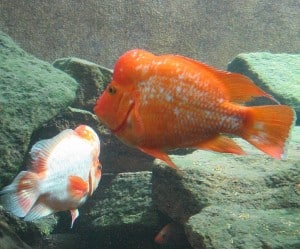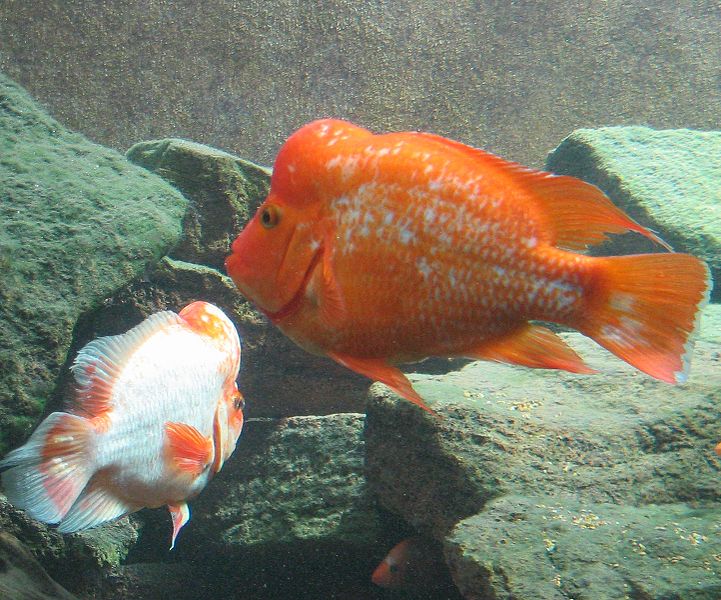
Common Name: Red Devil, Midas Cichlid
Scientific Name: Amphilophus Citrinellus
Average Adult Fish Size: 12 inches / 30.5 cm , but specimens up to 16 inches / 40.6 cm are not uncommon.
Place of Origin: Nicaragua, Costa Rica
Typical Tank Setup: Rocks, caves and driftwood / bogwood. Since the Red Devil can be a prodigious digger, it is advisable to place heavy objects, like large rocks, directly on the aquarium glass to avoid accidents.
Recommended Minimum Aquarium Capacity: 55 gallon / 220 litre for one. 120 gallon / 480 litre or larger for a pair.
Compatibility: Very aggressive. Keep only with other aggressive S. or Central American Cichlids, plecostomus, or large catfish. This fish is a predator by nature and will eat any fish that will fit in its mouth!
Temperature: 21 – 26 Deg C / 70 – 79 Deg F
Water Chemistry: pH 6.5 – 8.0 with 7.0 preferred
Feeding: The Red devil cichlid is an opportunistic predator that eat a wide range of different food in the wild. Even though it is mainly carnivorous, it will need plant matter in its diet. If you keep your Red devil cichlid in an unplanted aquarium, it is even more important that you regularly include lettuce, boiled peas or something similar in the diet. A varied diet is recommended. You can for instance use a high-quality pellet food for predators as a base, and supplement it with fish, earthworms, snails and insects.
Sexing: Sexing mature Red devil cichlids is not hard, since the adult male Red devil cichlid develops a prominent bump on his forehead and has a pointy genital papilla. The male is also typically bigger than the female.While these characteristics may help an experienced hobbyist, venting is the only sure way to determine gender of smaller specimens.
Breeding: The Red devil cichlids form monogamous pairs and both sexes participate in the rearing of their offspring. Before any spawning takes place, the male can be very aggressive towards the female. It is therefore important that the female have many suitable hiding spots in the aquarium. You can also include a net in the set up with an opening that is too small for the male Red devil cichlid to swim through. If the female have no place to escape in the aquarium, she can die of injury or become severely ill from the stress. Provide a large flat surface, such as a piece of slate for the female to lay her eggs on. The newly hatched offspring will feed on mucus extracted through the skin of the adult fish. The parents will continue to guard their offspring, and after roughly five days the fry are large enough to start swimming around the aquarium. The fry will accept small live food such as micro-worms or baby brine shrimp (BBS) or finely crushed flake food.
Additional Information: There exists a wide range of different color variations in Red devil cichlids, and two Red devil cichlids from two different geographical regions can display very dissimilar colors. You can for instance get a yellow Red devil cichlid, an orange Red devil cichlid, or an orange-red Red devil cichlid. There is also a small number of white Red devil cichlids to be found. Roughly 10 percent of the Red devil cichlids are xanthomorphic and will alter their coloration as they grow older.


Related Posts
Croaking Gourami – Trichopsis vittatus
Benthochromis Tricoti
Large-eyed Mouthbrooder – Callochromis Macrops